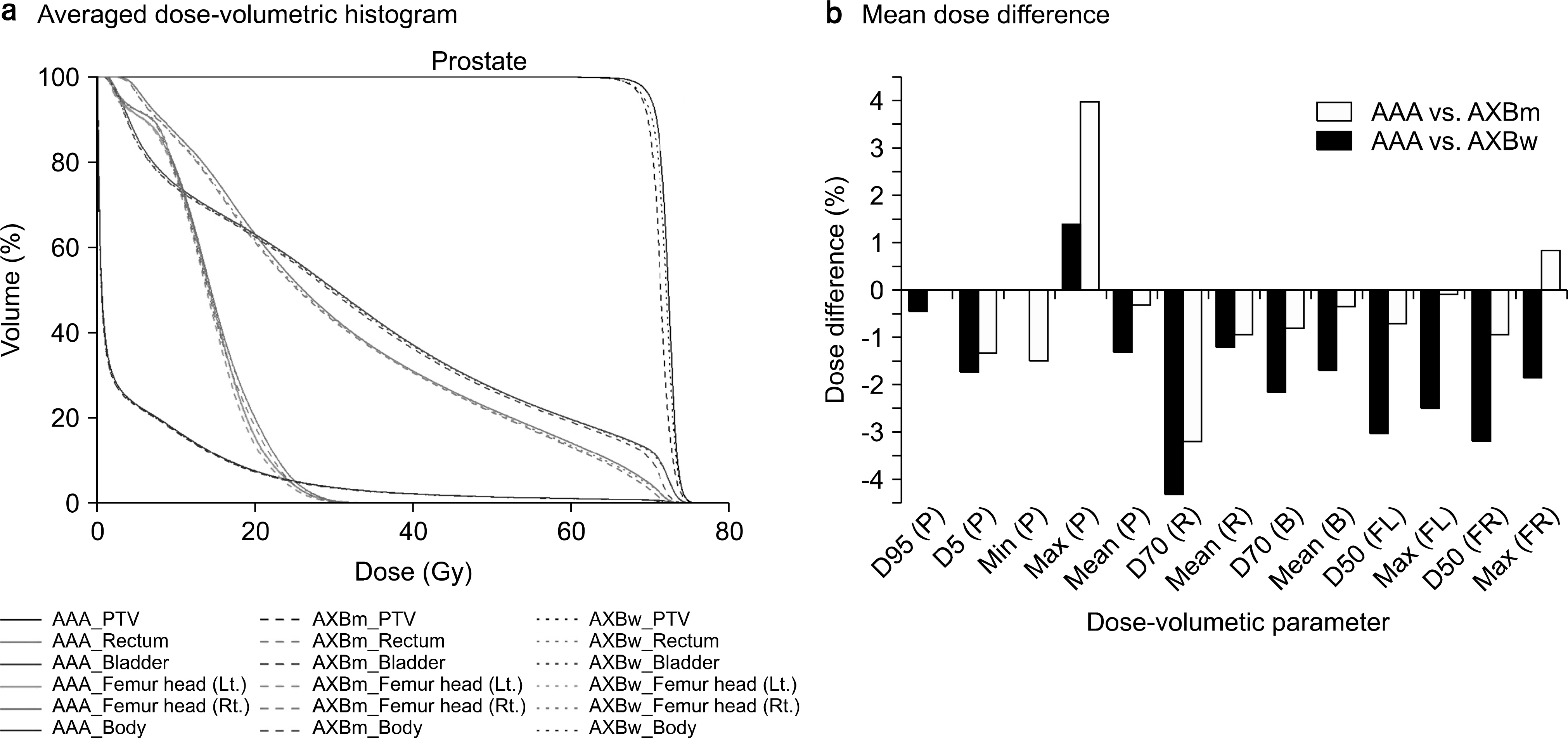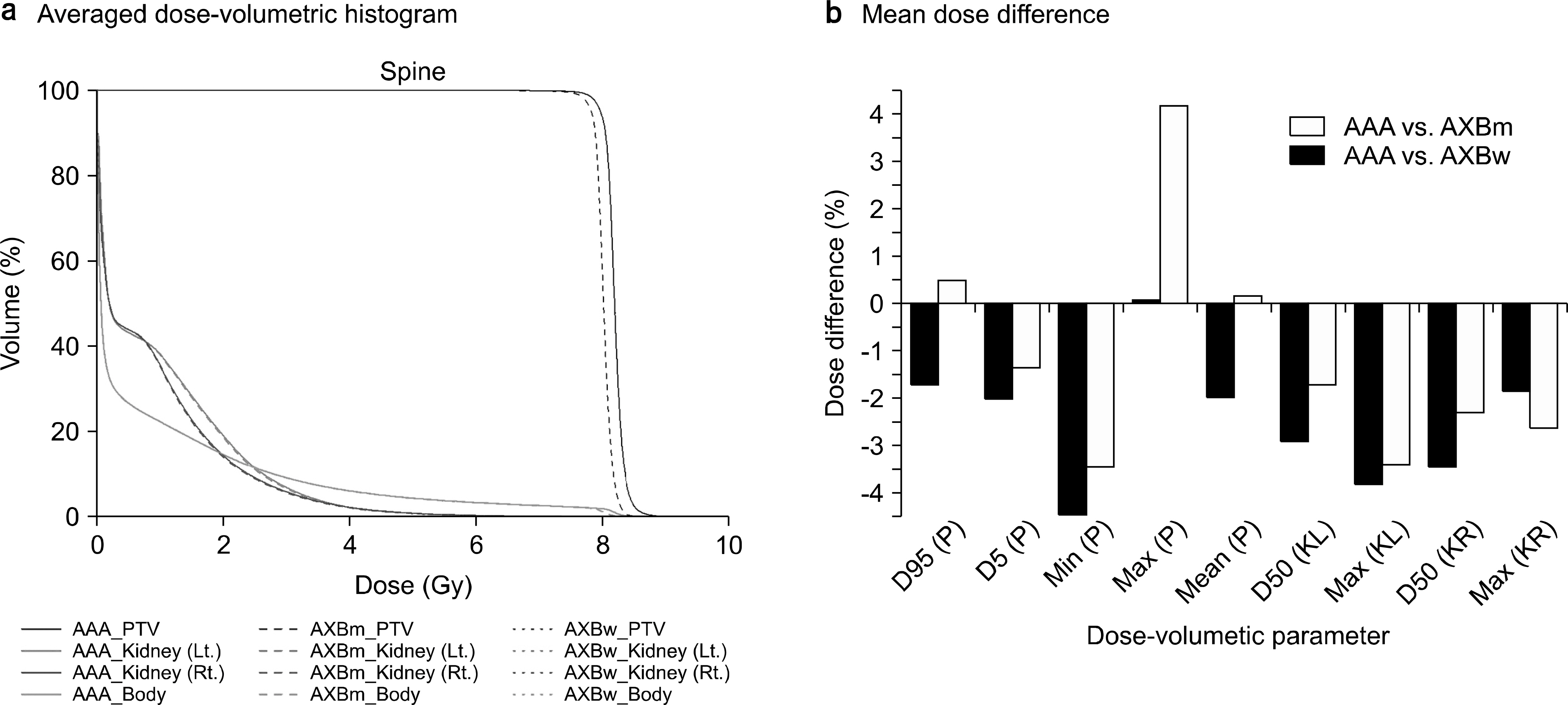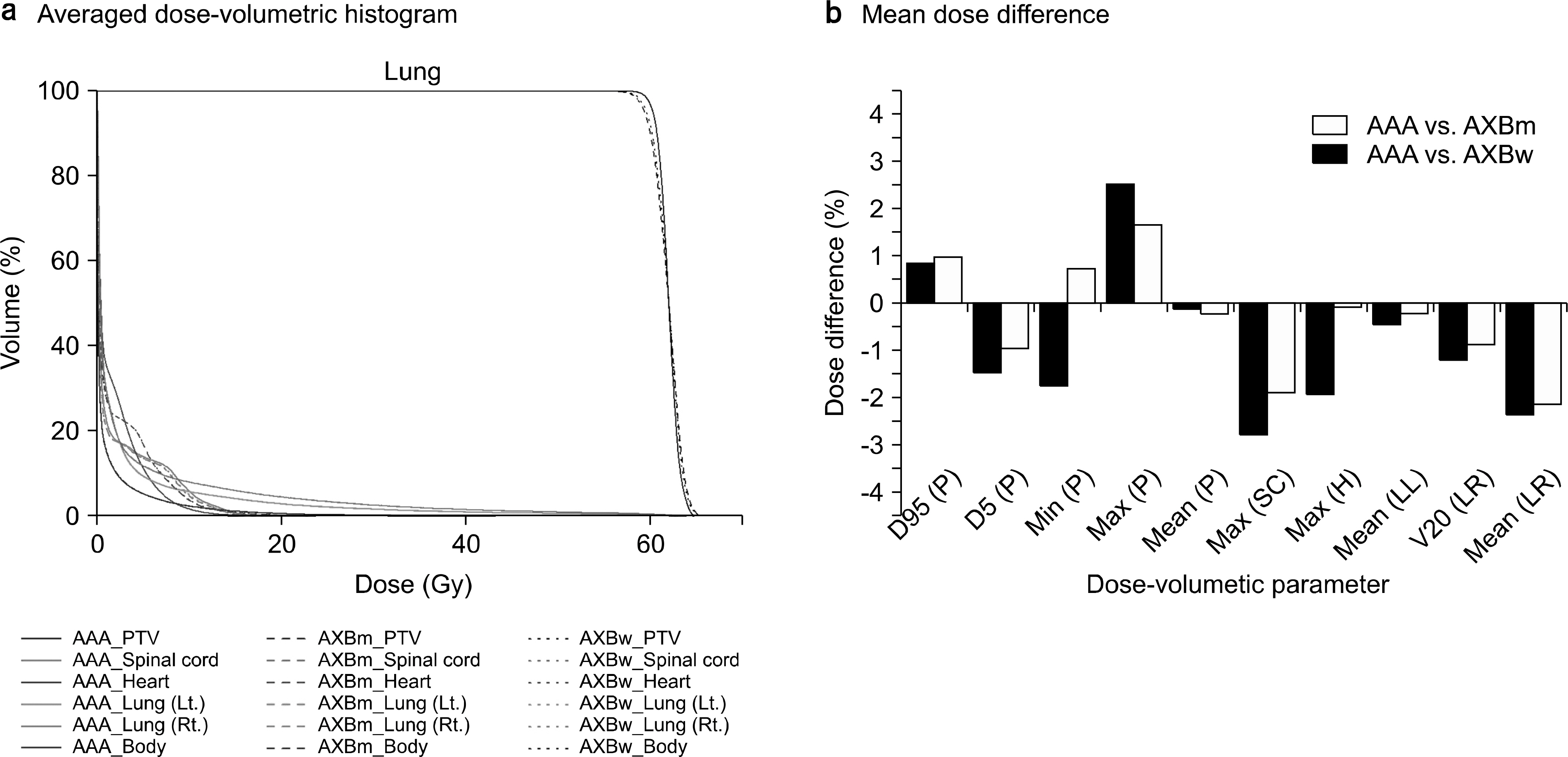Prog Med Phys.
2016 Dec;27(4):180-188. 10.14316/pmp.2016.27.4.180.
Dosimetric Validation of the Acuros XB Advanced Dose Calculation Algorithm for Volumetric Modulated Arc Therapy Plans
- Affiliations
-
- 1Department of Radiation Oncology, Seoul National University Hospital, Seoul, Korea. madangin@gmail.com
- 2Institute of Radiation Medicine, Seoul National University Medical Research Center, Seoul, Korea.
- 3Biomedical Research Institute, Seoul National University College of Medicine, Seoul, Korea.
- 4Center for Convergence Research on Robotics, Advance Institutes of Convergence Technology, Suwon, Korea.
- 5Interdisciplinary Program in Radiation Applied Life Science, Seoul National University College of Medicine, Seoul, Korea.
- KMID: 2376550
- DOI: http://doi.org/10.14316/pmp.2016.27.4.180
Abstract
- Acuros XB advanced dose calculation algorithm (AXB, Varian Medical Systems, Palo Alto, CA) has been released recently and provided the advantages of speed and accuracy for dose calculation. For clinical use, it is important to investigate the dosimetric performance of AXB compared to the calculation algorithm of the previous version, Anisotropic Analytical Algorithm (AAA, Varian Medical Systems, Palo Alto, CA). Ten volumetric modulated arc therapy (VMAT) plans for each of the following cases were included: head and neck (H&N), prostate, spine, and lung. The spine and lung cases were treated with stereotactic body radiation therapy (SBRT) technique. For all cases, the dose distributions were calculated using AAA and two dose reporting modes in AXB (dose-to-water, AXB(w), and dose-to-medium, AXB(m)) with same plan parameters. For dosimetric evaluation, the dose-volumetric parameters were calculated for each planning target volume (PTV) and interested normal organs. The differences between AAA and AXB were statistically calculated with paired t-test. As a general trend, AXB(w) and AXB(m) showed dose underestimation as compared with AAA, which did not exceed within −3.5% and −4.5%, respectively. The maximum dose of PTV calculated by AXB(w) and AXB(m) was tended to be overestimated with the relative dose difference ranged from 1.6% to 4.6% for all cases. The absolute mean values of the relative dose differences were 1.1±1.2% and 2.0±1.2% when comparing between AAA and AXB(w), and AAA and AXB(m), respectively. For almost dose-volumetric parameters of PTV, the relative dose differences are statistically significant while there are no statistical significance for normal tissues. Both AXB(w) and AXB(m) was tended to underestimate dose for PTV and normal tissues compared to AAA. For analyzing two dose reporting modes in AXB, the dose distribution calculated by AXB(w) was similar to those of AAA when comparing the dose distributions between AAA and AXB(m).
Keyword
Figure
Reference
-
1. Otto K. Volumetric modulated arc therapy: IMRT in a single gantry arc. Med Phys. 35:310–317. 2008.
Article2. Park JM, Kim IH, Ye SJ, Kim K. Evaluation of treatment plans using various treatment techniques for the radiotherapy of cutaneous Kaposi's sarcoma developed on the skin of feet. J Appl Clin Med Phys. 15:4970. 2014.3. Park JM, Kim K, Chie EK, Choi CH, Ye SJ, Ha SW. RapidArc vs intensity-modulated radiation therapy for hepatocellular carcinoma: a comparative planning study. Br J Radiol 85, e323-329. 2012.4. Park JM, Wu HG, Kim JH, Carlson JN, Kim K. The effect of MLC speed and acceleration on the plan delivery accuracy of VMAT. Br J Radiol. 88:20140698. 2015.5. Jin H, Jesseph FB, Ahmad S. A comparison study of volumetric modulated Arc therapy quality assurances using portal dosimetry and MapCHECK 2. Prog Med Phys. 25:7. 2014.6. Mattes MD, Lee JC, Elnaiem S, Guirguis A, Ikoro NC, Ashamalla H. A predictive model to guide management of the overlap region between target volume and organs at risk in prostate cancer volumetric modulated arc therapy. Radiat Oncol J. 32:23–30. 2014.
Article7. Borgers C. Complexity of Monte Carlo and deterministic dose-calculation methods. Phys Med Biol. 43:517–528. 1998.8. Gifford KA, Horton JL, Wareing TA, Failla G, Mourtada F. Comparison of a finite-element multigroup discrete-ordinates code with Monte Carlo for radiotherapy calculations. Phys Med Biol. 51:2253–2265. 2006.
Article9. Vassiliev ON, Wareing TA, McGhee J, Failla G, Salehpour MR, Mourtada F. Validation of a new grid-based Boltzmann equation solver for dose calculation in radiotherapy with photon beams. Phys Med Biol. 55:581–598. 2010.
Article10. Han T, Mikell JK, Salehpour M, Mourtada F. Dosimetric comparison of Acuros XB deterministic radiation transport method with Monte Carlo and model-based convolution methods in heterogeneous media. Med Phys. 38:2651–2664. 2011.
Article11. Bush K, Gagne IM, Zavgorodni S, Ansbacher W, Beckham W. Dosimetric validation of Acuros XB with Monte Carlo methods for photon dose calculations. Med Phys. 38:2208–2221. 2011.12. Fogliata A, Nicolini G, Clivio A, Vanetti E, Mancosu P, Cozzi L. Dosimetric validation of the Acuros XB Advanced Dose Calculation algorithm: fundamental characterization in water. Phys Med Biol. 56:1879–1904. 2011.
Article13. Lloyd SA, Ansbacher W. Evaluation of an analytic linear Boltzmann transport equation solver for high-density inhomogeneities. Med Phys. 40:011707. 2013.14. Kron T, Clivio A, Vanetti E, Nicolini G, Cramb J, Lonski P, et al. Small field segments surrounded by large areas only shielded by a multileaf collimator: comparison of experiments and dose calculation. Med Phys. 39:7480–7489. 2012.
Article15. Han T, Mourtada F, Kisling K, Mikell J, Followill D, Howell R. Experimental validation of deterministic Acuros XB algorithm for IMRT and VMAT dose calculations with the Radiological Physics Center's head and neck phantom. Med Phys. 39:2193–2202. 2012.
Article16. Han T, Followill D, Mikell J, Repchak R, Molineu A, Howell R, et al. Dosimetric impact of Acuros XB deterministic radiation transport algorithm for heterogeneous dose calculation in lung cancer. Med Phys. 40:051710. 2013.17. Kathirvel M, Subramanian S, Clivio A, Arun G, Fogliata A, Nicolini G, et al. Critical appraisal of the accuracy of Acuros-XB and Anisotropic Analytical Algorithm compared to measurement and calculations with the compass system in the delivery of RapidArc clinical plans. Radiation Oncology 8. 2013.18. Huang B, Wu L, Lin P, Chen C. Dose calculation of Acuros XB and Anisotropic Analytical Algorithm in lung stereotactic body radiotherapy treatment with flattening filter free beams and the potential role of calculation grid size. Radiat Oncol. 10:53. 2015.19. Hirata K, Nakamura M, Yoshimura M, Mukumoto N, Nakata M, Ito H, et al. Dosimetric evaluation of the Acuros XB algorithm for a 4 MV photon beam in head and neck intensity-modulated radiation therapy. J Appl Clin Med Phys. 16:5222. 2015.20. Rana S, Rogers K, Lee T, Reed D, Biggs C. Dosimetric impact of Acuros XB dose calculation algorithm in prostate cancer treatment using RapidArc. J Can Res Ther. 9:430–435. 2013.
Article21. Zhen H, Hrycushko B, Lee H, Timmerman R, Pompos A, Stojadinovic S, et al. Dosimetric comparison of Acuros XB with collapsed cone convolution/superposition and anisotropic analytic algorithm for stereotactic ablative radiotherapy of thoracic spinal metastases. J Appl Clin Med Phys. 16:5493. 2015.22. Liu HH. Dm rather than Dw should be used in Monte Carlo treatment planning. For the proposition. Med Phys. 29:922–923. 2002.23. Walters BR, Kramer R, Kawrakow I. Dose to medium versus dose to water as an estimator of dose to sensitive skeletal tissue. Phys Med Biol. 55:4535–4546. 2010.
Article24. Rana S, Pokharel S. Dose-to-medium vs. dose-to-water: Dosimetric evaluation of dose reporting modes in Acuros XB for prostate, lung and breast cancer. Int J Cancer Ther Oncol. 2:020421. 2014.25. Fogliata A, Nicolini G, Clivio A, Vanetti E, Cozzi L. Dosimetric evaluation of Acuros XB Advanced Dose Calculation algorithm in heterogeneous media. Radiat Oncol. 6:82. 2011.26. Kan MW, Leung LH, Yu PK. Dosimetric impact of using the Acuros XB algorithm for intensity modulated radiation therapy and RapidArc planning in nasopharyngeal carcinomas. Int J Radiat Oncol Biol Phys 85, e73-80. 2013.27. Kathirvel M, Subramanian S, Clivio A, Arun G, Fogliata A, Nicolini G, et al. Critical appraisal of the accuracy of Acuros-XB and Anisotropic Analytical Algorithm compared to measurement and calculations with the compass system in the delivery of RapidArc clinical plans. Radiat Oncol. 8:140. 2013.28. Fogliata A, Nicolini G, Clivio A, Vanetti E, Cozzi L. Critical appraisal of Acuros XB and Anisotropic Analytic Algorithm dose calculation in advanced non-small-cell lung cancer treatments. Int J Radiat Oncol Biol Phys. 83:1587–1595. 2012.
Article29. Robinson D. Inhomogeneity correction and the analytic anisotropic algorithm. J Appl Clin Med Phys. 9:112–122. 2008.
Article30. Liu HW, Nugent Z, Clayton R, Dunscombe P, Lau H, Khan R. Clinical impact of using the deterministic patient dose calculation algorithm Acuros XB for lung stereotactic body radiation therapy. Acta Oncologica. 53:324–329. 2014.
Article31. Fogliata A, Vanetti E, Albers D, Brink C, Clivio A, Knoos T, et al. On the dosimetric behaviour of photon dose calculation algorithms in the presence of simple geometric heterogeneities: comparison with Monte Carlo calculations. Phys Med Biol. 52:1363–1385. 2007.
Article32. Beam Configuration Reference Guide. Varian medical system. 2009.
- Full Text Links
- Actions
-
Cited
- CITED
-
- Close
- Share
- Similar articles
-
- Dosimetric Comparison of Noncoplanar and Coplanar Volumetric Modulated Arc Therapy Plans for Esophageal Cancer
- Comparison of Anisotropic Analytic Algorithm Plan and Acuros XB Plan for Lung Stereotactic Ablative Radiotherapy Using Flattening Filter-Free Beams
- Dosimetric Comparison between Varian Halcyon Analytical Anisotropic Algorithm and Acuros XB Algorithm for Planning of RapidArc Radiotherapy of Cervical Carcinoma
- Dosimetric comparison of volumetric modulated arc therapy with robotic stereotactic radiation therapy in hepatocellular carcinoma
- Dosimetric Evaluation of Low-Dose Spillage Volumes for Head and Neck Cancer Using Intensity-Modulated Radiation Therapy and Volumetric Modulated Arc Therapy Treatment Techniques





